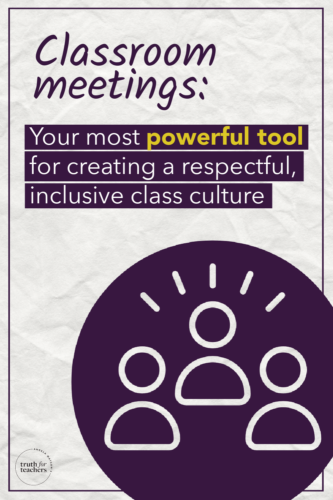How we start the school year communicates who we expect students are and how we expect students will act.
Informed by our prior experiences in the classroom, these expectations become a form of bias that can create rigid roles for both students and ourselves that we then spend the entire year navigating. An alternate approach, where teachers co-construct community and rules with students, is certainly more welcoming. Without a dedicated ritual, this approach can lose steam throughout the year with students and teachers reverting to internal norms.
A happy middle comes via classroom meetings, an idea I first read about in Positive Discipline in the Classroom: Developing Mutual Respect, Cooperation, and Responsibility in the Classroom by Jane Nelsen and Lynn Lott. The premise is simple: holding a weekly class meeting keeps a group high-functioning by anticipating the group’s ongoing needs to connect and solve problems.

Listen to my interview with Jennifer, the author of this post!
Click PLAY or use the download button to listen later, and hear additional anecdotes and examples:
Sponsored by Planbook, Scholastic Scope, and Midwest Teachers Institute
Class meeting ideas that build community and establish expectations
There are a few basic procedures for class meetings, but you can make this work for you and your students. You may see overlap between restorative justice/circle training and class meetings, so bring in that knowledge if you have the training.
1. Classroom meetings happen regularly (ideally once a week) and last 15-20 minutes.
2. The meeting can be used to resolve class conflicts, review expectations, and/or build community.
3. Everyone sits in a circle (on the floor, in desks, or outside). I like to add a focal point to the middle to take the pressure off of eye contact. I have a fake bouquet of flowers in a vase that I use.
4. Participation is not mandatory. I pass a talking piece (historically, a stuffed monkey). When it comes to a student, they may speak or pass the monkey along. This gives everyone the option to speak, but not the requirement. By making it voluntary, you will get a sense of the group’s power dynamics and personalities.
You will also find out whether the topic you chose resonates with the group. By letting students come as they are and show up how they choose to, they may share when they are actually ready or moved to do so, and the conversation will be much more authentic. When the participation can be more popcorn-style, I use a foam ball that students can toss around.
5. Once the procedure is established, students can anonymously submit topics for either a community-building or problem-solving meeting. When the students don’t submit a topic, then the teacher can identify a topic.
Using classroom meetings to start building community
The first meeting of the year, which could be the first day of class, should be reserved for building community to set the foundation for honest work around expectations. For the first meeting, try a prompt that is aspirational and accessible. Some examples:
- In your lifetime, what do you want to be, do, or have?
- This or that? (e.g. cats or dogs, chocolate or peanut butter, etc.)
- Tell us about another first day of school that you remember.
These prompts can be used in an ongoing way, whenever there isn’t any “formal” meeting content. Check in with students about their dreams. Ask this or that questions. Ask them to tell a story from their lives about some topic.
Fire pit is a storytelling activity where you give students a topic and they share popcorn-style as they are led, like people do around an actual fire pit. Students can ask questions of each other between stories if one is particularly juicy. If you teach writing, this could become a gold mine for idea generation.
Using classroom meetings to establish expectations and solve problems
The second classroom meeting of the year is a great time to discuss expectations. It has long been suggested that teachers who declare behavioral expectations in an authoritarian style have less success maintaining them, not to mention potentially becoming complicit in the school-to-prison pipeline. An alternative approach suggests establishing rules together, but when I have tried this across a five-period day, I end up enforcing five different sets of vague rules (i.e. “respect each other”) that don’t necessarily include what I know I need to do my job well.
The class meeting is a happy compromise, but it must be grounded in a positive-discipline mindset. Nelsen and Lott offer three key beliefs:
1. Expectations are boundaries that help everyone do their best work.
In selecting topics for the classroom meeting, it is helpful to examine your own needs. If you are not chill about phones, do not pretend to be chill about phones. Knowing and owning your peeves builds trust, because students don’t have to guess what matters to you. That being said, not everything can matter. Get clear on what matters most to you.
This post from Angela on creating classroom rules goes into greater detail. If other behaviors that get under your skin crop up, unless it is a safety issue, bless and release caring about them. You only have so much time and energy. Same goes for students, who at the secondary level could be managing the expectations of 7-8 adults across their school days.
They can’t spend the year wandering through a minefield of what will set you off. If the expectation isn’t stated and predictable, students will be more likely to wonder if it is something about them in particular that is causing your reaction.
By choosing a few boundaries to enforce that you know are important to teaching and learning, you will be able to be more consistent across students and days, and in turn, reduce the risk of bias, as well as protect your peace. If the rationale is clear to you and your students, then they know that while they might not love the rule, they know you have their best interest in mind. My three areas are technology, attendance, and inclusion, but these might not be yours.

2. Barriers to upholding expectations are problems to be solved together.
There’s a spiral that can happen when a student does not uphold an expectation. A teacher can take it personally, assuming the student is being disrespectful, and then (surprise) how the teacher responds can be less-than-respectful, and it goes on from there. Instead, think of it as a problem to be solved together.
Let’s say a student keeps texting the entire class period. There could be a lot of reasons for extensive phone use, such as wanting to be there for family and friends, anxiety, or boredom. Our job, as experienced problem-solvers, is to find a way to get both our needs met. This collaborative stance is less biased than a combative one that assumes ill or frivolous intent.
Furthermore, I have struggled again and again with my own phone boundaries in my free time, so I can draw from that experience to teach students how to manage their ongoing relationships with their devices. Knowing that a student will have that same meandering course of incremental improvement that I have had helps me have more empathy and patience. This attention to our collective humanity enables everyone to thrive.
3. Expectations are stated in positive language so everyone knows what to do.
While this is fairly common knowledge, I like making the language something I can say clearly as often as I need to. By having something prepared to say that students also see posted, they know I’m not coding my language to a particular student or publicly shaming them. I’m also less likely to be passive-aggressive or make jokes that can come across as passive-aggressive. By having the language clear, I can detach from how I’m feeling and say what needs to be said without saying what shouldn’t be said. Here are some examples:
- “Please put your phone in your backpack and include yourself in your group, the activity, etc.”
- “I’m glad you’re here today. Please put your pass on my desk if you were able to get one and join us in ______.”
- “We are listening to (student’s name) right now. Let’s make sure they feel heard.”
Classroom Meeting Questions
With those ends in mind, there are three base questions to ask about the areas you know you need an expectation that will serve as the basis for the first expectations class meeting of the year. Common topics might be attendance, technology, and inclusion, but depending on the age of students, as well as your own values, there might be other areas instead of or in addition to. Here are the sample questions for attendance.

The question stems can be applied across a variety of topics.
“What are the effects of…?” helps us get at rationale. If we’ve done the groundwork here, I can appeal to these effects any time a student and I need to solve a problem.
“Why do students…?” is where we get the opportunity to normalize openness and acknowledge systemic barriers. The students tend to start with schoolish, “safe” answers, but I can push them:
- Parents/guardians might refuse to call the student in because the student should be in school.
- Parents/guardians might already be at work.
- Parents/guardians might not know how to call a student in or be able to communicate with the office.
- Students might choose to hang out with friends who have an open period or support a friend in crisis instead of going to class.
- Students might choose to finish an assignment for another class instead of going to class.
- The school might not recognize the reason why the student was absent.
By airing this publicly, I signal that I am open to reality (not upset with reality), and therefore, a better partner for problem-solving.

“How could students solve their particular causes for…?” allows students to brainstorm solutions, which when recorded become a class problem-solving guide. This process reveals that some problems are not as straightforward to solve as others, depending on the reasons behind them. As students discuss how to answer this question, they may find thought-partners in class that they could go to if they are experiencing one of the barriers. Because it’s framed as a hypothetical, everyone can save face, and yet, everyone is visible.
If a student gets stuck on a problem in our class (or another class), they can apply the guide to their situation. I can refer to the guide when I need to have a talk with a student, and because it’s already in the guide, it feels less like a personal attack from me. I can send the guide to families, so they too can partner with us, as well as find helpful information, like how to get a district interpreter.
There may be times in which accepting the institutional consequence is actually the right move and not a problem to be solved. A few years ago, the sixth-grade girls at one school in my district disrupted a dress-code policy by wearing spaghetti straps. Per the rule, they were all supposed to be sent home, but this peaceful resistance showed how the rule disproportionately affected female students and their learning, and the rule was abolished. To this end, preparing students to explain how and why they are disrupting an inequitable policy should also be part of the guide-making.
Classroom Meeting Agenda
With the questions prepared ahead of time, the agenda can flow as follows.
- Introduce the structure of classroom meetings as a way to solve problems and emphasize that any problems that arise in class can be solved by working together.
- Use the talking piece to get feedback from the circle on each question while you record their answers on a projected document that will become your class guide. If you get nothing but crickets, this can be done in small groups by assigning one topic and its three questions to each small group. You can have them record notes on a document that they share with you. Multiple groups can be assigned the same topic.
- If students are sticking with schoolish thinking (e.g. “just don’t be late for school”), when the talking piece comes back to you, throw out some alternate scenarios: “I once had a student who was late everyday because he had to drop his sister off at her school first. He couldn’t just get here on time. What should he do?” The guide may need to be revisited across several meetings to ensure its completion (or as new scenarios present themselves). This will also reinforce it as an actual tool to be used.
- Introduce your class expectations and the support you will provide to help students meet them. In my example, the students didn’t set the technology, attendance, or inclusion expectations–those came from my building and me–but they got the investment of figuring out how they were going to meet the expectations together.

Communicating Positive Expectations and Tiers of Intervention

These are the expectations and supports I shared with students after the meeting. If you work in a PBIS school, this may feel familiar to you, but I implemented this work without PBIS in my school. After the expectations are shared, I make some promises to students: that I will provide engaging lessons, positive recognition, clear rationales, and problem-solving guidance.
If I default on this core, I don’t have much business critiquing student behavior. This universal support can be spot-checked during a class meeting too. In fact, any time a student offers a critique of the class, I invite them to bring the concern to a class meeting.
Once I have discussed my promises, I describe when and how things may escalate if solutions are not reached in the early stages. I take copious short-hand notes of whom I am reminding about what and when. I don’t expect perfection, but I do expect some accountability. If my reminders are not getting through, I am going to try something else, and it is going to be planned.
Assuming reminders will be enough for everyone and then kicking someone out when you finally get sick of reminding them is not a helpful way to go, for you or the student. Without a system, bias will be involved, as some students will get more patience than others. It might be clear to you why some students are getting more chances than others, but to the students, it’s not.
When I can share with students how many times (and on what days) I have asked them to do something, they see the pattern more objectively. Furthermore, when I have moved a student to a different tier of intervention, I no longer remind them, which frees me up to focus on other students as well as break a pattern of corrective interaction, both of which disrupt any negative bias I may be building or projecting toward a student. Sometimes when the reminders fade and they’re not getting as much attention from me, students take the opportunity to get themselves back on track. For more ideas, check out 5 Pro-Active Strategies for Positive Behavior Management.
Meeting Activities Throughout the Year
While community-building activities like the Fire Pit are great default activities, the rest of the meetings will be spaces for addressing student-submitted issues, adding scenarios to the class guide, or addressing data around a large-scale problem (e.g. “80% of you were on your phones during work time yesterday. What’s going on?”). If the data isn’t actually large-scale, it is best to bring the observation up with individual students.
Again, this is bias in action. If it was actually only four students, it doesn’t require holding the whole class hostage (but we’ve all done this, right?!). This type of meeting benefits from some ground rules about how we talk to each other without placing blame or refusing responsibility. Any restorative circles you may need to do could also happen during this time.
Classroom Meetings That Matter
If you’ve read this post and want to get started with classroom meetings for building community, modeling healthy conflict resolution, and inspiring everyone to bring their best selves to class each day, I’m so glad you’re here.
Let’s start with my free resource. In today’s freebie, you’ll find a copy of my discussion questions, notes guide, expectations, and tiers of intervention, along with templates and a completely editable Google copy. I have used this resource to establish expectations and classroom meetings in my 11th-grade classroom, but it can be adapted and applied across a variety of contexts.
By approaching expectations with positivity, openness, and collaboration, you set the tone for the school year, showing that you are on your students’ side, and that your only bias toward them is a favorable one. Download it here.

Want more?
Listen to my interview with Jennifer as she expands on the ideas shared here.
Subscribe to Truth for Teachers in your podcast app,
You can also use the play or download buttons below.
The Truth for Teachers Podcast
Our weekly audio podcast is one of the top K-12 broadcasts in the world, featuring our writers collective and tons of practical, energizing ideas. Support our work by subscribing in your favorite podcast app–everything is free!
Explore all podcast episodes
Jennifer Brinkmeyer
7th-12th Grade ELA
OR

Join our
community
of educators
If you are a teacher who is interested in contributing to the Truth for Teachers website, please click here for more information.





















